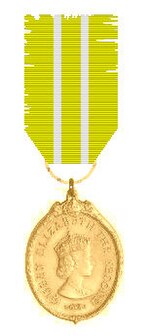
The British florin, or two-shilling piece, was a coin worth 1⁄10 of one pound, or 24 pence. It was issued from 1849 until 1967, with a final issue for collectors dated 1970. It was the last coin circulating immediately prior to decimalisation to be demonetised, in 1993, having for a quarter of a century circulated alongside the ten-pence piece, identical in specifications and value.

The British threepence piece, usually simply known as a threepence, thruppence, or thruppenny bit, was a denomination of sterling coinage worth 1⁄80 of one pound or 1⁄4 of one shilling. It was used in the United Kingdom, and earlier in Great Britain and England. Similar denominations were later used throughout the British Empire and Commonwealth countries, notably in Australia, New Zealand and South Africa.

The Air Force Medal (AFM) was a military decoration, awarded to personnel of the Royal Air Force and other British Armed Forces, and formerly to personnel of other Commonwealth countries, below commissioned rank, for "an act or acts of valour, courage or devotion to duty whilst flying, though not in active operations against the enemy". The award was discontinued in 1993 when all ranks became eligible for the Air Force Cross (AFC) as part of the reform of the British honours system.

The Distinguished Flying Medal (DFM) was a military decoration awarded to personnel of the Royal Air Force and other British Armed Forces, and formerly to personnel of other Commonwealth countries, below commissioned rank, for "exceptional valour, courage or devotion to duty whilst flying in active operations against the enemy". The award was discontinued in 1993 when all ranks became eligible for the Distinguished Flying Cross (DFC) as part of the reform of the British honours system.
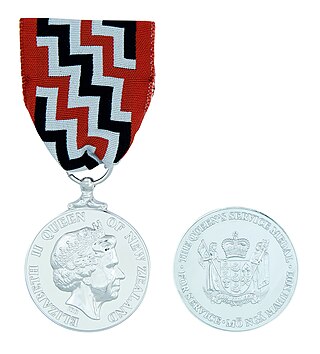
The Queen's Service Medal is a medal awarded by the government of New Zealand to recognise and reward volunteer service to the community and also public service in elected or appointed public office. It was established in 1975 and is related to the Queen's Service Order. The QSM replaced the Imperial Service Medal as an award of New Zealand.
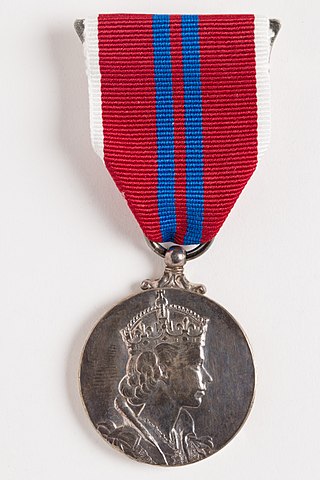
The Queen Elizabeth II Coronation Medal is a commemorative medal instituted to celebrate the coronation of Queen Elizabeth II on 2 June 1953.
The Royal Victorian Medal (RVM) is a decoration established by Queen Victoria in April 1896. A part of the Royal Victorian Order, it is a reward for personal service to the Sovereign or the royal family, and is the personal gift of the Sovereign. It differs from other grades of the order in appearance and in the way it is worn.
The threepence or threepenny bit was a denomination of currency used by various jurisdictions in England, Ireland, Scotland and Wales, valued at 1/80 of a pound or 1⁄4 of a shilling until decimalisation of the pound sterling and Irish pound in 1971. It was also used in some parts of the British Empire, notably Australia, New Zealand and South Africa.
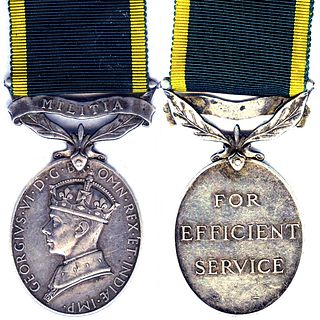
The Efficiency Medal was instituted in 1930 for award to part-time warrant officers, non-commissioned officers and men after twelve years of efficient service on the active list of the Militia or the Territorial Army of the United Kingdom, or of the other Auxiliary Military Forces throughout the British Empire. At the same time a clasp was instituted for award to holders of the medal upon completion of further periods of six years of efficient service.

The Efficiency Medal (South Africa) was instituted in 1930 for award to part-time warrant officers, non-commissioned officers and men after twelve years of efficient service on the active list of the Citizen Force of the Union of South Africa. At the same time, a clasp was instituted for award to holders of the medal upon completion of further periods of six years of efficient service. The medal superseded the Colonial Auxiliary Forces Long Service Medal.

The Police Long Service and Good Conduct Medal is a decoration for police officers of the United Kingdom. First instituted in 1951, the medal is presented for twenty aggregate years of service in the police services of the United Kingdom.
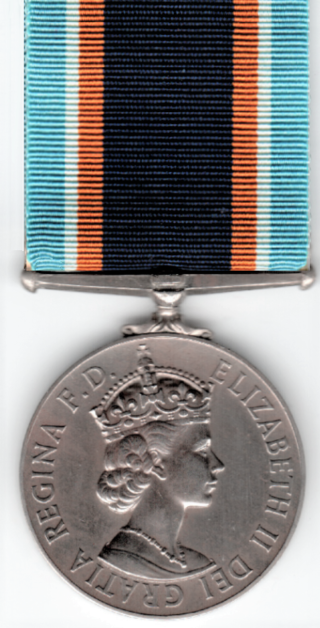
The Ceylon Police Long Service Medal was awarded to police officers in Ceylon of and below the rank of Chief Inspector for completing 18 years of unblemished service. Bars for 25 and 30 years service were also awarded.

The New Zealand Suffrage Centennial Medal 1993 was established by Royal Warrant on 1 July 1993. It was created to commemorate Women's suffrage in New Zealand and to recognize those New Zealand and Commonwealth citizens who had made a significant contribution to women's rights or women's issues in New Zealand. The medal was only awarded in 1993.
The Long Service and Good Conduct Medal is a military award recognizing 14 years of exemplary and unblemished service by non-commissioned and other ranks members of the New Zealand Defence Force. Established in 1985, these medals replaced the British Long Service and Good Conduct Medals with specific versions for New Zealand. There are three version of the Long Service and Good Conduct Medal, one each for the New Zealand Army, Royal New Zealand Navy, and the Royal New Zealand Air Force.
The Ulster Defence Regiment Medal is a long service medal awarded to part-time members of the Ulster Defence Regiment. Established in 1982, the medal was awarded for 12 years of long and efficient service, with a bar being awarded for each subsequent six years of qualifying service. Officers awarded the medal were entitled to use the post-nominal UD. The medal was replaced by the Northern Ireland Home Service Medal in 1992. Full-time members of the Ulster Defence Regiment were eligible for the Medal for Long Service and Good Conduct after 15 years of service.

The Colonial Police Long Service Medal was established in 1934 to recognise long service in the police forces of the colonies and overseas territories of the United Kingdom. On 10 April 2012 the medal became known as the Overseas Territories Police Long Service Medal.

The Colonial Fire Brigades Long Service Medal, now known as the Overseas Territories Fire Brigades Long Service Medal, was established in 1934 to recognise long service in the fire services of the colonies and overseas territories of the United Kingdom.

The Queen's Medal for Champion Shots of the New Zealand Naval Forces was retrospectively instituted for New Zealand in 1958, the first medal having already been awarded in 1955. The medal is a Naval counterpart of the Queen's Medal for Champion Shots in the Military Forces and the Queen's Medal for Champion Shots of the Air Forces. One medal can be awarded annually to the champion shot of a small-arms marksmanship competition held by the Royal New Zealand Navy.

The Colonial Special Constabulary Medal was established on 1 April 1957 as a volunteer and part-time long service medal of the United Kingdom and the Commonwealth. On 10 April 2012 the medal became known as the Overseas Territories Special Constabulary Medal, and underwent a minor change in design. This reflected the change in the way Britain's remaining colonies were described, they being classed as 'Overseas Territories' from 2002.

The Mauritius Police Long Service and Good Conduct Medal was awarded by the Dominion of Mauritius between 1968 and 1992 to members of the Mauritius Police who completed eighteen years service.
